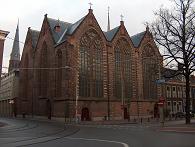Kloosterkerk, The Hague
| Kloosterkerk | |

The Kloosterkerk
|
|
| Location | Lange Voorhout, The Hague |
|---|---|
| Country | Netherlands |
| Denomination | Protestant Church in the Netherlands |
| Website | http://www.kloosterkerk.nl/ |
| History | |
| Dedication | (as former Catholic church) Vincent Ferrer |
| Architecture | |
| Functional status | active |
| Heritage designation | Rijksmonument status |
The Kloosterkerk (or Cloister Church) is a church on the Lange Voorhout in The Hague, Netherlands. The church and its accompanying monastery were first built in 1397. The church is known today as the church where Beatrix of the Netherlands occasionally attends services.
Origins of the original monastery and church that occupied this site may be found in the Dominican Order. Reforms undertaken by Raymond of Capua, brought a renewed growth to the order, and it is around this time in 1397 that a monastery and church was first built for the Dominicans in The Hague.
A thriving new center of arts was established in The Hague by the Court of Albrecht of Bavaria (1336–1404) and his second wife Margaret of Cleves (ca. 1375-1412). Some known artistic products to have been produced in this period are an important illuminated manuscript, the Hours of Margaret of Cleves commissioned between 1395-1400, and the visually similar Biblia pauperum. From December 1399 Dirc van Delf (ca. 1365-ca. 1404) was among the court of the Duke Albrecht of Bavaria in The Hague. There he had the function of court chaplain, but he also lectured at German universities, such as Cologne and Erfurt.
In 1420 a fire raged through the monastery, but serious renovations are not recorded until the church's southern transept was added in the beginning of the 16th century. The church was expanded around 1540 with an enlarged aisle and side chapels. The center barrel vaulted aisle is 20 meters high and 11.5 meters wide. The worship space became a pilgrimage church, where people could visit and pass through, while services were being held in the central aisle or nave. At this time the church was also dedicated to St. Vincent, a Valencian Dominican missionary who was canonized June 3, 1455 by Pope Calixtus III.
It was stripped of Catholic decorations during the beeldenstorm (iconoclasm of 1566). A number of monks lived on for a few more years, but in 1574 the last few monks left. After being abandoned for 12 years, the church had deteriorated and some suggested to tear it down. In 1588 a cavalry company seeking shelter settled in the former church. The following year the church and choir were made into a cannon foundry for the States of Holland and West Friesland. The choir was used as a foundry and the church served as a munition store with the two walled off from each other. On November 3, 1690, the ammunition stored in the church exploded leaving only one wall of the monastery remaining. The monastery then temporarily served as a hospital. In 1583 most of the monastery was demolished, though the (now Protestant) church remained.
...
Wikipedia
